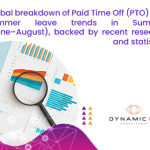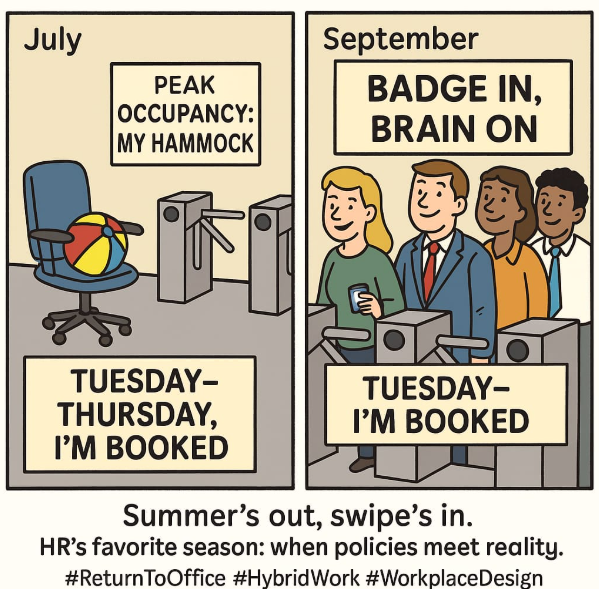
Global breakdown of Paid Time Off

The September Snap-Back: What “Return-to-Office Season” Really Does—By Region

After the summer lull, September reliably brings a “snap-back” in office attendance as schools resume and annual leave winds down. Booking/occupancy platforms show a July dip and a rebound across August–September—so HR teams should expect tighter desk utilization, fuller mid-week peaks, and a fresh wave of policy-compliance conversations.
Americas
In the U.S., keycard data shows weekly office occupancy hovering just above the halfway mark and edging higher in 2025 (January hit a post-pandemic high ~54%). Peak days remain Tue–Thu, with Fridays materially lower—so capacity planning and services (catering, shuttle schedules) should be dynamically aligned to those peaks. Meanwhile, policy enforcement is tightening: more firms report hitting attendance goals, and 43% of North American occupiers now plan to expand office footprints—especially in higher-grade buildings.
Latin America’s pattern diverges: hybrid is widespread (JLL finds 72% of companies in LatAm using a hybrid model; Brazil higher). Even as CDMX and major Brazilian markets recover, the dominant operating model is “structured hybrid,” so HR should prioritize equitable performance management across in-office and remote days, not a wholesale reversion to five-day office norms.
Europe
Europe’s return is steadier but more heterogeneous. The UK illustrates the paradox: office occupancy remains modest (UK average c. 38% in late May), yet British knowledge workers are among the most remote-leaning in Europe (about 1.8 WFH days per week vs. ~1.3 global). For HR, that means September attendance bumps without a structural break from hybrid; focus on re-onboarding routines and “peaks management” (meeting room friction and elevator congestion) rather than blanket mandates.
GCC (Gulf)
The GCC is the outlier leaning hardest toward in-office. UAE employment advisers increasingly frame a five-day return as “inevitable,” even as Dubai briefly encouraged WFH to ease congestion. Market data backs the preference: Dubai and Abu Dhabi show surging demand, new supply, and high occupancy in premium assets. The HR implication: September means a full facilities ramp (badging, parking, reception staffing) and strict policy execution—often with attendance tied to performance/variable pay in multinationals operating locally.
Asia
Asia is bifurcated. In India’s tech hubs, large employers continue to ratchet up in-office expectations—e.g., TCS moving parts of its workforce to five days, Infosys standardizing at least 10 in-office days per month—producing noticeable September surges after summer. Japan remains more office-centric than the West; telework rates hover around the low-20%s and fluctuate with public-transport loads, so the seasonal effect shows up more as meeting-room congestion and overtime spikes than a policy shift. Net-net, Asia’s September is less about mandate changes and more about operational smoothing: shuttle/bus timetables, staggered core hours, and visitor management.
Africa
Across Africa’s main office markets, September accentuates a trend that’s been building: falling vacancies and a flight to quality. South Africa’s vacancy rates have been easing since 2023, with brokers reporting continued improvement into early 2025. In West Africa, prime Lagos submarkets such as Ikoyi report occupancy in the 80s–90s and new supply in the pipeline through 2027. Expect September to tighten parking, security queues, and food-service bottlenecks; HR should coordinate closely with landlords on peak-day capacity.
What HR should do now (quick wins)
Seat:Employee ratios by peak day: Re-forecast Tue–Thu ratios and hot-desking buffers; target <85% peak utilization at neighborhood level to avoid spillover.
Commute-aware scheduling: Use telemetry (badge + meeting analytics) to offer glidepaths (e.g., 10:30–3:30 cores) during the first two September weeks.
Policy with incentives, not just mandates: Pair attendance expectations with purpose (client days, learning tracks) and tangible perks; many North American occupiers expanding space are doing so to stage intentional collaboration.
Fair performance calibration: In hybrid-heavy regions (LatAm, UK), decouple visibility from impact; make OKRs and calibration cycles location-agnostic.
Supplier alignment: In GCC and parts of Africa, confirm SLAs with facilities and catering for full occupancy weeks; September is effectively “Q4 kickoff.”